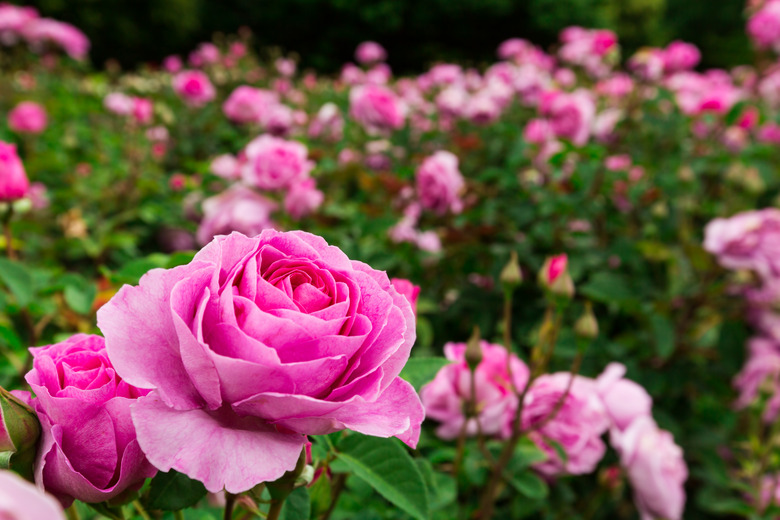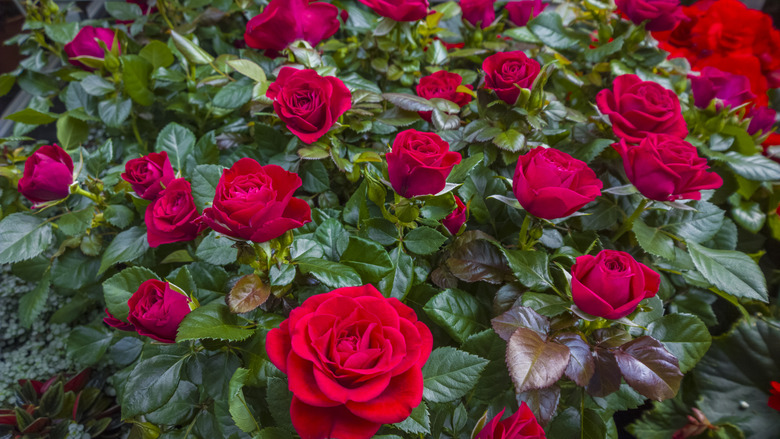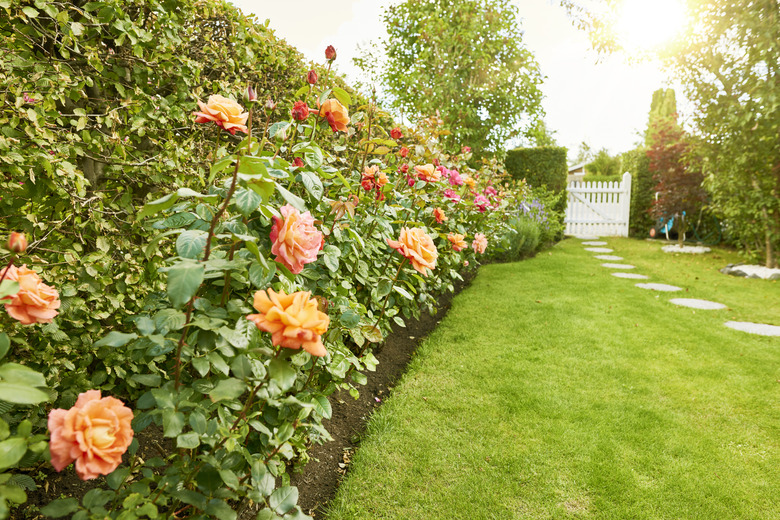How To Grow Roses
We may receive a commission on purchases made from links.
Roses (Rosa spp.) are one of the oldest types of flowers in cultivation, and they have totally won the hearts of gardeners as America's most popular flower. The rose is a perennial plant that cross-breeds easily, which explains the thousands of varieties available to gardeners in addition to species roses that have grown in the wild for centuries. Some roses are relatively easy to care for, and others are fussy. Gardeners need to pick the flowers for their rose garden carefully, keeping the climate, level of sun exposure, and soil in mind.
Best Uses for Roses
Best Uses for Roses
Roses are ornamental. Their job is purely to add beauty to the world with their silky petals, their gorgeous colors, and their unforgettably romantic fragrances. There are so many types from which to choose that you'll find roses that work in almost any landscape situation.
The choice won't be easy. Inspect your garden site carefully before you dive in. There are rosebushes that are less than a foot tall with wee flowers. There are others — climbers and ramblers — that mount some 30 feet up your house wall, over a fence, or up a towering tree. Others are stand-alone upright shrub roses. Some roses bloom in early summer and some in fall, and the color range is astonishing. In addition to species roses, you can find old-fashioned roses, also known as heirloom roses, that are lush and fragrant, and there are modern hybrids that bloom longer and are cold hardy.
Given the different types of roses available, you can use them in many parts of your landscape. You can grow roses in beds, borders, or containers on the deck or patio. They can spill out of window boxes or even form a flowering hedge.
How to Grow Roses
How to Grow Roses
Starting Roses From Seedlings
Starting Roses From Seedlings
Although wild or species roses produce seeds in rose hips and these seeds can be used to grow new roses, very few gardeners grow roses from seeds. Most people buy young plants to install in the garden or elsewhere in the landscape. The two most common presentations are bare-root roses and container roses. The planting methods are slightly different.
For both bare-root and container roses, spacing is the same. If you are planting more than one in a location, you must give the rosebushes some elbow room. Leave a space on either side of a rose equal to two-thirds of the expected height. This spacing depends to some degree on the type of rose. Miniature roses can be planted closer, while heirlooms require a bit more space.
Bare-root roses look like dead sticks, but don't be fooled. These are roses that are fully dormant. They are sold in spring before the plants leaf out. If you buy them early, keep them in a chilly, dark location until planting a month or so before the last spring frost. Soak the plant roots in water for at least eight hours and up to 24 hours before planting. When it is time to plant, be sure to wear gloves since many roses have thorns. Even thornless roses may sport the occasional thorn. Trim each cane to leave only three to five buds. Before planting, prune off and dispose of any canes that are broken or pencil thin. If you're planting a grafted rose, also prune any suckers that may have sprouted below the graft union.
To plant a bare-root rose, dig a hole about three times as wide as the plant and just deep enough to accommodate the roots. Create a mound from the soil in the base of the hole and position the bare-root plant on it, spreading its roots over the mound. Fill the planting hole halfway with the removed soil, tamp it down, and water it thoroughly. After that, fill the rest of the hole and water again. Mound dirt or mulch around the rosebush to keep it moist, removing this little by little so that it is gone five weeks after planting and making sure that the graft union is above the soil line.
Plant potted rosebushes later in spring after the last frost. Dig a hole about three times as wide and only as deep as the pot so the plant will be sitting at the same depth as it was in the container. Backfill the hole with the removed soil. In both bare-root and container rose plantings, dig out a saucer in the dirt, creating a circular wall around it to capture water. If your soil is poor or compacted, amend the entire planting area — not just the hole(s) you dig — with organic matter before planting roses.
In What Zone Do Roses Grow Best?
In What Zone Do Roses Grow Best?
Most roses grow best in U.S. Department of Agriculture plant hardiness zones 5 though 9, although some species and cultivars are cold hardy to zone 2 and others sail through the heat in zone 11. With numerous rose species and many more cultivars, there is likely a rose for your climate. Before you select a rose, figure out your region's plant hardiness zone.
Every garden store, both brick-and-mortar and online, should identify the hardiness zones in which each rose will grow. Often the hardiness zones are listed on the rose label. If you buy from a store in your city or neighborhood, it is very likely that the rose will match your zone. If you buy online, you'll need to clarify this carefully.
Are there really roses that grow in icy zones like 2 and 3? Yes, there are. Rosa 'Adelaide Hoodless' is a Canadian rose that is hardy in USDA zone 2. This large red rose offers semidouble blooms from June until the first frost.
When Should You Plant Roses?
When Should You Plant Roses?
Bare-root roses are sold when they are fully dormant. They can be stored in a cool area until they are ready for planting. Ideally they should go into the ground in early spring before the leaves are ready to emerge. This can be a month or more before the last frost in spring.
If you purchase container-grown plants — that is, potted plants — then late spring is when you should be planting roses. This gives the plants a good start for the growing season, but the truth is you are transplanting them from one growing location to another, and you can do this successfully at nearly any time during the growing season.
Soil, Sunlight, and Water Recommendations for Roses
Soil, Sunlight, and Water Recommendations for Roses
Excellent drainage is one of the primary cultural requirements to grow roses. They will die quickly if they are planted in mud or wet soil and left there for any length of time. Ideally, roses should be planted on organically rich, moisture-retentive, loose loam. Blend organic matter, such as compost, into the soil before planting to increase drainage and fertility. The soil pH should be between 6.5 and 7.0.
The second critical requirement for roses is sun, and the more sun they get, the more flowers you will have to enjoy. All roses should receive at least six to eight hours of direct sun every day. As usual, in extremely hot climates, all plants, including roses, appreciate a little afternoon sun protection. In colder regions, plant the roses near a wall that faces west or south for more flowers and better winter survival rates.
Nobody could call roses drought-tolerant. They are among the most thirsty landscape plants, and frequent irrigation — some 2 inches a week — is essential during the rose's first year in your garden. It is during this period that it is establishing roots. This should be cut in half when the plant is established. Drip irrigation is the method of choice, allowing you to direct water to the root area and avoid getting the leaves wet, a factor in a variety of fungal diseases. Add organic mulch to help keep moisture in the soil.
How to Winterize Roses
How to Winterize Roses
The colder the winters where you live, the more you should do to keep your roses safe and happy during the off-season. First be sure you select roses that are hardy in your growing zone. This is critical. Roses hardy to zone 6, for example, can survive zone 6 winters without any special measures taken to protect them.
However, it never hurts to make it a little easier on your plants. Stop deadheading roses a month before the first hard frost so that you don't encourage new growth. In fact, you shouldn't be pruning roses in the fall other than to remove broken or dead branches.
After a few weeks of frosts, pile a foot of soil or mulch on the base of your roses. If your winters include months of freezing weather, build a sturdy mesh cylinder around the plant and then fill the inside with straw, mulch, pine needles, or compost. For extra protection, wrap the cylinder with protective garden fabric.
Common Pests and Other Problems for Roses
Common Pests and Other Problems for Roses
Japanese beetles are the beetles that pester roses the most. They are easy to spot thanks to their iridescent green bodies and copper-colored wing covers. They feed during the day using their chewing mouthparts to chow down on the roses themselves as well as the rosebuds and leaves. Look for ragged edges and/or holes in the petals. Rose leaves are typically skeletonized or eaten completely. Handpicking is a great option for Japanese beetles. Grab one at a time and drop it into soapy water.
The rose aphid is the predominant species of aphid that feeds on roses. All aphids are small, but these are truly tiny, not growing over 1/8 inch long. These aphids have soft, pear-shaped bodies in shades of pink or green and tend to cluster on the bottoms of leaves and around buds. Aphids pierce the rose leaves with their mouthparts and then suck out the juices. While a few rose aphids won't do much harm, an infestation reduces the number of flowers and the quality of the roses. Aphids also deposit a sticky waste called honeydew on the rose leaves. This draws other pests and can cause sooty mold fungus to develop.
You can remove aphids with a stream of water from your garden hose, but you'll likely need to repeat this process throughout the growing season. Try to avoid wetting the foliage late in the day when the leaves won't have time to dry before nighttime. Wet leaves cause other problems, such as fungal diseases. You can also use insecticidal soap to control aphids.
Spider mites are not insects at all; they are arachnids related to spiders. They are even smaller than rose aphids at some 1/50 of an inch long, so don't expect them to stand out on a rose plant. If you suspect mites, hold a piece of printer paper under a branch, tap the branch and then run your hand over the paper. Red streaks mean you have spider mites. Like aphids, they pierce foliage and suck out the plant sap. You will notice speckling on the top of the leaf and fine webbing on the underside. Treat spider mite infestations with insecticidal soap, following all label recommendations.
Common Diseases for Roses
Common Diseases for Roses
Fungal diseases are common among roses, including powdery mildew and leaf spot. It is far easier to prevent these diseases than to combat them. Prevention is based largely on two rules. Never water in a manner that gets the leaves wet, especially in the evening, and space the plants far enough apart to allow air circulation between them. Consider growing disease-resistant roses, such as some of the rugosa roses or plants in the Knock Out and Meidiland series, which are less susceptible to fungal diseases, particularly if your garden is in a humid climate.


